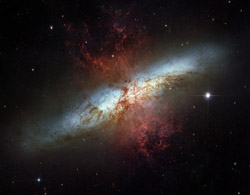Happy sweet sixteen, Hubble Space Telescope

This mosaic image of the magnificent starburst galaxy, Messier 82 (M82) is the sharpest wide-angle view ever obtained of M82. It is a galaxy remarkable for its webs of shredded clouds and flame-like plumes of glowing hydrogen blasting out from its central regions where young stars are being born 10 times faster than they are inside in our Milky Way Galaxy.
To celebrate the NASA-ESA Hubble Space Telescope’s 16 years of success, the two space agencies are releasing this mosaic image of the magnificent starburst galaxy, Messier 82 (M82). It is the sharpest wide-angle view ever obtained of M82, a galaxy remarkable for its webs of shredded clouds and flame-like plumes of glowing hydrogen blasting out from its central regions.
Throughout the central region of Messier 82, young stars are being born 10 times faster than they are inside in our Milky Way Galaxy. These numerous hot new stars emit not only radiation but also particles called a stellar wind. Stellar winds streaming from these hot new stars also have combined to form a fierce galactic superwind. This superwind compresses enough gas to make millions more stars and blasts out towering plumes of hot ionised hydrogen gas, above and below the disk of the galaxy (seen in red in the image).
In M82 young stars are crammed into tiny but massive star clusters which themselves then congregate by the dozen to make the bright patches or “starburst clumps” seen in the central parts of M82. The individual clusters in the clumps can only be distinguished in the ultra-sharp Hubble images. Most of the pale objects sprinkled around the main body of M82 that look like fuzzy stars are actually star clusters about 20 light-years across and containing up to a million stars.
The rapid rate of star formation in this galaxy will eventually be self-limiting. When star formation becomes too vigorous, it will destroy the material needed to make more stars and the starburst will subside, probably in a few tens of millions of years.
Located 12 million light-years away, M82 appears high in the northern spring sky in the direction of the constellation Ursa Major, the Great Bear. It is also called the “Cigar Galaxy” because of the elongated elliptical shape produced by the tilt of its starry disk relative to our line of sight.
The observation was made in March 2006 with the Advanced Camera for Surveys’ Wide Field Channel. Astronomers assembled this 6-image composite mosaic by combining exposures taken with four coloured filters that capture starlight from visible and infrared wavelengths as well as the light from the glowing hydrogen filaments.
Hubble was launched on April 24, 1990, aboard the space shuttle Discovery.
Media Contact
All latest news from the category: Physics and Astronomy
This area deals with the fundamental laws and building blocks of nature and how they interact, the properties and the behavior of matter, and research into space and time and their structures.
innovations-report provides in-depth reports and articles on subjects such as astrophysics, laser technologies, nuclear, quantum, particle and solid-state physics, nanotechnologies, planetary research and findings (Mars, Venus) and developments related to the Hubble Telescope.
Newest articles

Superradiant atoms could push the boundaries of how precisely time can be measured
Superradiant atoms can help us measure time more precisely than ever. In a new study, researchers from the University of Copenhagen present a new method for measuring the time interval,…

Ion thermoelectric conversion devices for near room temperature
The electrode sheet of the thermoelectric device consists of ionic hydrogel, which is sandwiched between the electrodes to form, and the Prussian blue on the electrode undergoes a redox reaction…

Zap Energy achieves 37-million-degree temperatures in a compact device
New publication reports record electron temperatures for a small-scale, sheared-flow-stabilized Z-pinch fusion device. In the nine decades since humans first produced fusion reactions, only a few fusion technologies have demonstrated…





















